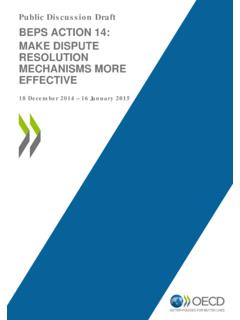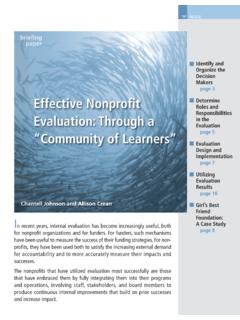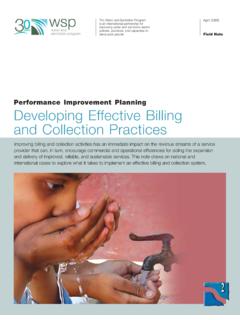Transcription of Effective Aggregate Design Part I: Modeling a …
1 Effective Aggregate Design part I: Modeling a Single Aggregate Vaughn Vernon: Clustering entities and value objects into an Aggregate The concepts of this domain, along with its performance with a carefully crafted consistency boundary may at first and scalability requirements, are more complex than any of seem like quick work, but among all [DDD] tactical guid- them have previously faced. To address these issues, one of ance, this pattern is one of the least well understood. the DDD tactical tools that they will employ is Aggregate . To start off, it might help to consider some common ques- How should the team choose the best object clusters? The tions. Is an Aggregate just a way to cluster a graph of Aggregate pattern discusses composition and alludes to in- closely related objects under a common parent? If so, is formation hiding, which they understand how to achieve. It there some practical limit to the number of objects that also discusses consistency boundaries and transactions, but should be allowed to reside in the graph?
2 Since one ag- they haven't been overly concerned with that. Their chosen gregate instance can reference other Aggregate instances, persistence mechanism will help manage atomic commits can the associations be navigated deeply, modifying various of their data. However, that was a crucial misunderstanding objects along the way? And what is this concept of invari- of the pattern's guidance that caused them to regress. Here's ants and a consistency boundary all about? It is the answer what happened. The team considered the following state- to this last question that greatly influences the answers to ments in the ubiquitous language: the others. Products have backlog items, releases, and sprints. There are various ways to model aggregates incorrectly. New product backlog items are planned. We could fall into the trap of designing for compositional convenience and make them too large. At the other end of New product releases are scheduled. the spectrum we could strip all aggregates bare, and as a New product sprints are scheduled.
3 Result fail to protect true invariants. As we'll see, it's imper- ative that we avoid both extremes and instead pay attention A planned backlog item may be scheduled for to the business rules. release. A scheduled backlog item may be committed to a Designing a Scrum Management Application sprint. The best way to explain aggregates is with an example. From these they envisioned a model, and made their first Our fictitious company is developing an application to sup- attempt at a Design . Let's see how it went. port Scrum-based projects, ProjectOvation. It follows the traditional Scrum project management model, complete with product, product owner, team, backlog items, planned First Attempt: Large-Cluster Aggregate releases, and sprints. If you think of Scrum at its richest, The team put a lot of weight on the words Products have . that's where ProjectOvation is headed. This provides a fa- in the first statement. It sounded to some like composition, miliar domain to most of us.
4 The Scrum terminology forms that objects needed to be interconnected like an object the starting point of the ubiquitous language. It is a graph. Maintaining these object life cycles together was subscription-based application hosted using the software as considered very important. So, the developers added the a service (SaaS) model. Each subscribing organization is following consistency rules into the specification: registered as a tenant, another term for our ubiquitous lan- guage. If a backlog item is committed to a sprint, we must not allow it to be removed from the system. The company has assembled a group of talented Scrum ex- perts and Java However, their experience with If a sprint has committed backlog items, we must DDD is somewhat limited. That means the team is going to not allow it to be removed from the system. make some mistakes with DDD as they climb a difficult If a release has scheduled backlog items, we must learning curve. They will grow, and so can we.
5 Their not allow it to be removed from the system. struggles may help us recognize and change similar unfa- vorable situations we've created in our own software. If a backlog item is scheduled for release, we must not allow it to be removed from the system. 1 Although the examples use Java and Hibernate, all of this material is applicable to C# and NHibernate, for instance. 1. As a result, Product was first modeled as a very large ag- Persistence mechanisms are used in this general way to deal gregate. The root object, Product, held all Backlog with If you argue that the default concurrency Item, all Release, and all Sprint instances associated configurations can be changed, reserve your verdict for a with it. The interface Design protected all parts from inad- while longer. This approach is actually important to protect- vertent client removal. This Design is shown in the follow- ing Aggregate invariants from concurrent changes. ing code, and as a UML diagram in Figure 1: These consistency problems came up with just two users.
6 Public class Product extends ConcurrencySafeEntity { Add more users, and this becomes a really big problem. private Set<BacklogItem> backlogItems;. private String description;. With Scrum, multiple users often make these kinds of over- private String name; lapping modifications during the sprint planning meeting private ProductId productId; and in sprint execution. Failing all but one of their requests private Set<Release> releases;. private Set<Sprint> sprints;. on an ongoing basis is completely unacceptable. private TenantId tenantId;.. Nothing about planning a new backlog item should logic- } ally interfere with scheduling a new release! Why did Joe's commit fail? At the heart of the issue, the large cluster ag- gregate was designed with false invariants in mind, not real business rules. These false invariants are artificial con- straints imposed by developers. There are other ways for the team to prevent inappropriate removal without being ar- bitrarily restrictive.
7 Besides causing transactional issues, the Design also has performance and scalability drawbacks. Second Attempt: Multiple Aggregates Now consider an alternative model as shown in Figure 2, in which we have four distinct aggregates. Each of the de- pendencies is associated by inference using a common Figure 1: Product modeled as a very large Aggregate . ProductId, which is the identity of Product con- sidered the parent of the other three. The big Aggregate looked attractive, but it wasn't truly practical. Once the application was running in its intended multi-user environment it began to regularly experience transactional failures. Let's look more closely at a few cli- ent usage patterns and how they interact with our technical solution model. Our Aggregate instances employ optimistic concurrency to protect persistent objects from simultaneous overlapping modifications by different clients, thus avoid- ing the use of database locks. Objects carry a version num- ber that is incremented when changes are made and checked before they are saved to the database.
8 If the ver- Figure 2: Product and related concepts are modeled as sion on the persisted object is greater than the version on separate Aggregate types. the client's copy, the client's is considered stale and updates are rejected. Consider a common simultaneous, multi-client usage scen- Breaking the large Aggregate into four will change some ario: method contracts on Product. With the large cluster ag- gregate Design the method signatures looked like this: Two users, Bill and Joe, view the same Product public class Product .. {. marked as version 1, and begin to work on it.. public void planBacklogItem(. Bill plans a new BacklogItem and commits. String aSummary, String aCategory, The Product version is incremented to 2. BacklogItemType aType, StoryPoints aStoryPoints) {.. Joe schedules a new Release and tries to save, }.. but his commit fails because it was based on Product version 1. 2 For example, Hibernate provides optimistic concurrency in this way.}
9 The same could be true of a key-value store because the entire Aggregate is often serial- ized as one value, unless designed to save composed parts separately. 2. public void scheduleRelease( So we've solved the transaction failure issue by Modeling it String aName, String aDescription, Date aBegins, Date anEnds) { away. Any number of BacklogItem, Release, and .. Sprint instances can now be safely created by simultan- }. eous user requests. That's pretty simple. public void scheduleSprint(. String aName, String aGoals, However, even with clear transactional advantages, the four Date aBegins, Date anEnds) { smaller aggregates are less convenient from the perspect- .. }. ive of client consumption. Perhaps instead we could tune .. the large Aggregate to eliminate the concurrency issues. By }. setting our Hibernate mapping optimistic-lock op- tion to false, the transaction failure domino effect goes All of these methods are [CQS] commands. That is, they away.
10 There is no invariant on the total number of created modify the state of the Product by adding the new ele- BacklogItem, Release, or Sprint instances, so why ment to a collection, so they have a void return type. But not just allow the collections to grow unbounded and ignore with the multiple Aggregate Design , we have: these specific modifications on Product? What additional cost would there be in keeping the large cluster Aggregate ? public class Product .. {.. The problem is that it could actually grow out of control. public BacklogItem planBacklogItem( Before thoroughly examining why, let's consider the most String aSummary, String aCategory, BacklogItemType aType, StoryPoints aStoryPoints) {. important Modeling tip the team needed.. }. Rule: Model True Invariants In Consistency public Release scheduleRelease(. String aName, String aDescription, Boundaries Date aBegins, Date anEnds) {.. When trying to discover the aggregates in a bounded con- } text, we must understand the model's true invariants.}







